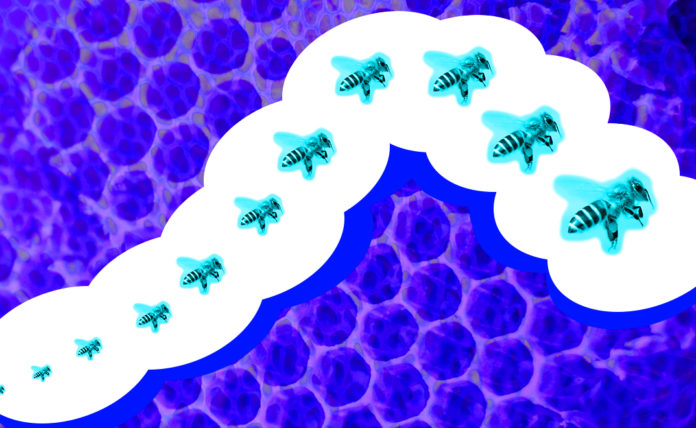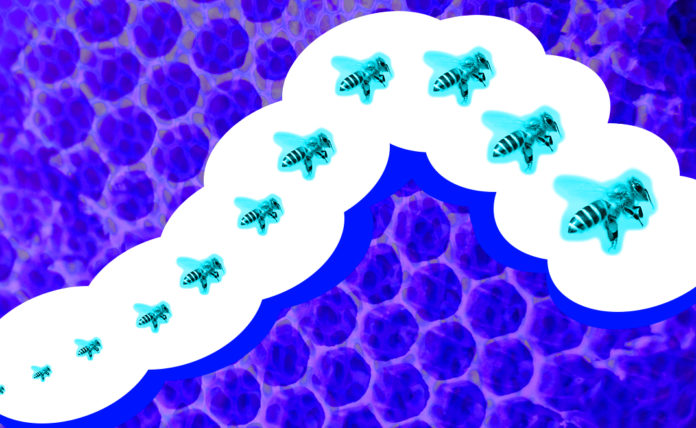

Swarm robots: what bees tell us about the future of IoT
The Internet of Things is about to undergo a giant leap that few people know about. This article will give you an in-depth look at “swarm robots” and how they can use bees and other social insects to change the world.

In the opening sequence of Black Mirror, a bee pollinates a daisy bathed in sunlight. And in a show known for exploring dark and dystopian futures, scenes like this are rare. It depicts a technology-based future where robots are used to improve lives, rather than harm them.

But then thousands of bees join in the attack on one woman. It’s clear that bees work as a unit and use real-time data to achieve a common goal.
What makes this episode unique is that it covers a technology that most media doesn’t understand and hasn’t explored. It points to the impact of a little-known technology that will change everything we know about the Internet of Things: swarm robots.
Swarm robotics is an exciting area of practice inspired by the proliferation of the Internet of Things. Until now, robotics has focused on creating advanced robots that work alone—think automated factory floors and friendly robot baristas popping up in Silicon Valley cafes and various airports.
But now, thanks to insights gleaned from nature, the unlikeliest of places, the field of robotics is evolving into something greater, as Black Mirror suggests. But before going too far down this road, it’s best to get a basic understanding of how swarm robots work, the background technology, and what they can really do now.
You must understand the reasons for swarm robots
Swarm technology is inspired by swarm intelligence, which takes inspiration from the life of social insects in nature. A major component is the communication improvements and feedback necessary when working as a team. It involves understanding the impact of changes in other robots in the team on the functionality of the team.
Most of us are aware of the way the Internet of Things is transforming homes into smart networks and the various convenience benefits this may bring. But connected thermostats, smart refrigerators, and Alexa-enabled washing machines all rely on a central “authority” to guide/manage/instruct/notify them what to do. Smart blinds open every morning, letting you welcome the sunshine without getting out of bed, but they don't talk to your connected security system to check if your neighbor happens to be standing near your bedroom window.
Swarm robots are different. They communicate horizontally with each other in a constantly changing environment, with no instructions from above telling them what to do.
Scientists are now beginning to investigate how swarm robots can be put to practical use in the Internet of Things. The world is on the brink of another technological revolution.
It’s time to learn about swarm robotics – the evolution of swarm robotics will forever be intertwined with the Internet of Things, and leaders who want to learn new directions in technology will have to pay close attention to what’s new in this space. Here you can learn about how it works, current applications and what the future will look like in terms of research and development.
What are swarm robots?
Swarm robotics is a field of simple robotics that focuses on coordinating large numbers of simple robots using local rules. As mentioned above, swarm robots are inspired by the life of social insects such as bees and ants. In which the power of the community is used to perform tasks beyond the capabilities of the individual.
In swarm robotics, a swarm of robots is not any swarm. It is constructed by imitating the functional characteristics of insect colonies:
1) Simple, almost identical members
2) Decentralized control
3) Lack of synchronicity
1. Inspiration for swarm robots
Social insects have a lot to teach us, from wasp nest building and bee coordination to termite mound construction and ant tracking. For a long time, we thought these were mysteries we would never understand.
However, recent research has shown that we can simulate these complex systems even without the complex knowledge originally thought necessary. In a social insect colony, individual members are unaware of the status of the entire colony. There is no one leader who directs the role of everyone else.
Instead, the colony's knowledge is distributed among the agents, which have systems for exchanging this information. However, individuals cannot fulfill their role unless the rest of the group plays their part.
In a swarm, individuals can exchange important information, such as food sources or imminent danger. This interaction is based on the concept of locality, so no one knows the whole picture. They adjust their behavior based on the behavior of peers with whom they are familiar with the situation. In termites, for example, changes in worker behavior are determined by nest structure.
2. Self-organizing behavior
Each agent's simple yet complex organizational system comes from observing and imitating others' interactions with other people and the environment. These interactions move through the group and help the group accomplish tasks that it cannot accomplish alone. This interaction is called self-organizing behavior.
Self-organization has four characteristics:
1) Multiple interactions
2) Randomness
3) Positive feedback
4) Negative feedback
These properties are also desirable when looking at a swarm robotic system:
1) Robustness. They should continue to work regardless of anyone failing or environmental interference.
2) Flexibility in decision-making. They should be able to create different solutions depending on the task.
3) Role flexibility. They should adapt to changing roles according to the needs of the moment.
4) Scalability. They should be able to work in teams of varying sizes, from a few robots to thousands.
These standards guide the development of swarm robotics technology.
3. Ideal characteristics of swarm robots
Based on the above definitions and properties, the following are standards for swarm robotics technology and system development:
1) The swarm must be composed of autonomous robots that can sense and perform actions in real life.
2) They should be composed of one large group or the largest group allowed by the control rules.
3) They should be homogeneous - there may be a few types in the colony, but not too many different types.
4) They cannot be independent - that is, the main task to be accomplished must require collaboration.
5) They must only have local perception and communication capabilities - they should not understand the overall situation/role of the group.
The characteristics embodied in swarm intelligence are borrowed from social insect colonies. In fact, biologists have played an important role in guiding research into swarm robotics.
The robot swarm is defined as a self-organizing multi-robot system with high redundancy as the main feature.
We could also say that they have local sensation and communication capabilities but no access to global information. Group behavior is the sum of the interactions of individual robots with their peers and their surrounding environment.
Why invest in swarm robots?
Due to the above characteristics, swarm robots can help us achieve flexible, scalable and fault-tolerant systems across dozens of commercial and industrial vertical fields.
Swarm robots can also be used to develop systems that can handle a variety of operating conditions and environments. Flexibility is possible because the population is self-organized and well-distributed. Robots dynamically assign tasks based on the requirements of their environment; they do not rely on any global information or existing infrastructure.
Swarm robots can also create scalable systems so that the introduction or removal of individuals does not affect the performance of the swarm. Localized sensing and communication supports scalability - provided the density of the cluster does not change significantly; each individual interacts with the same number of peers.
With swarm robotics we can create systems that adapt to the failure of one or more system components/component robots. Therefore, the failure of an individual does not lead to the failure of the entire group. This fault tolerance comes from the high redundancy of the swarm; there is no centralized control, leadership, or individuals in predefined roles.
Original author: Benjamin Shepardson
This article is from a translation, if you want to reprint, please obtain authorization from this site first.
